Spring tester / weight scale
This is another one I finished a couple months ago but haven’t posted. I wanted to test the rate of the springs in the coilover kit on my car, and manufacturers treat this like it’s some kind of trade secret. Except for a few; my kit was from Bilstein who gave me the rates but they weren’t very believable. I knew they were higher than what I was told.
So I built a spring tester. It is basically a weigh scale that can go up to 1000 pounds or so, with a way to safely compress the spring and measure displacement. For the scale I used four load cells with one at each corner of a 1/4″ aluminum plate and another 1/4″ plate to distribute the load to the four load cells and allow fixtures for various springs. The electronics for the load cells are INA103s and some more op-amps for gain. Since load cells are bridge devices a TDK DC-DC converter drives the in-amp rails with +/- 12V. The signal from the in-amps is offset and fed to an ATmega8 which does ADC and puts the values on an LCD. I am displaying the values for each load cell as well as the sum so I can see if any load cells are not being loaded equally which could result in an overload. There is also a button on an interrupt that allows zeroing the summed weight output.
To compress the spring I used a Harbor Freight hydraulic press. The spring is completely captured at the top and bottom, if you try this at home be very careful as compressed springs can be dangerous. I made a few different fixtures so that the springs could not move in the horizontal plane. I take no responsibility for anyone trying this, if you compress a spring without constraining it properly bad things can/will happen.
For displacement measurement I used a Mitutoyo linear scale I had but for this application it’s overkill, you could just tape a ruler to the side of the press.
So let’s get some results! Below is a plot of the stock spring, the garbage Bilstein spring, and the very nice Vogtland spring. Note that I’m not doing the typical 2″displacement minus 1″ displacement equals rate. I think that’s misleading especially since “progressive” springs are more common these days. I’ll explain why after the chart:
So Bilstein told me that the “working rate” for the B14 spring is 215 lbs/in. I’ve gathered that “working rate” means rate at ride height, which if you look at the graph is actually 366 lbs/in. This is the “secondary rate” after the dead coils have all collapsed. The rate Bilstein gave me is off by 70%. You would think they might be concerned about that but I couldn’t get anywhere with their tech people.
That’s the first problem with progressive springs, the meaningless measurements that manufacturers will rarely tell you anyway. The second problem I have with progressive springs is this: to get the secondary rate you have to put in extra coils that will flatten at a certain load/height. This severely limits the travel of the spring. The Bilstein spring at ride height only had about 1.25″ of available compression before full coil bind, which is exactly what it does over bigger bumps. The bumpstops would not engage before the spring would just slam flat. There are marks on the coils where the paint has worn off to demonstrate this. And seriously, only 1″ of compression travel? Fire that engineer. I’ll bet an F1 car has about an inch of compression travel.
In contrast consider the mostly linear Vogtland spring whose picture is at the top of this post. That picture is at ride height and there is still plenty of available travel, which means the bumpstops can do their thing and keep the car from feeling like riding in a wagon. Between the B14’s spring and ridiculous damping I can’t say anything good about it. It’s probably overdamped even for a race car, but I haven’t built my shock dyno so I can’t quantify that statement.
And as usual here is a schematic. Please note though that I messed up the output buffer stages in this diagram, guess I hadn’t had enough caffeine that night. It’s just supposed to be a unity gain buffer but it was shown here wired totally wrong.
And finally source code for the project.
7 Comments to Spring tester / weight scale
Leave a Reply
Other Stuff
Recent Posts
- 6CY7 dual triode valve amplifier
- Air quality sensor (TVOC and eqCO2)
- Automotive rear fill “surround sound” with Boss DD-3
- Spring tester / weight scale
- Ducati 749/999 Tail Light
- Instruments for the GSXR
- Light pipe tail light for the GSXR
- M17x 6990m / 6970m overheating
- PAR / Spectrum analyzer
- Acrylic polishing and scratch removal
Archives
- May 2019 (2)
- April 2017 (3)
- October 2015 (1)
- May 2015 (1)
- March 2014 (2)
- December 2013 (1)
- July 2013 (1)
- November 2012 (1)
- October 2012 (4)
- September 2012 (1)
- August 2012 (3)
- June 2012 (1)
- March 2012 (1)
- February 2012 (1)
- January 2012 (1)
- October 2011 (3)
- July 2011 (1)
- June 2011 (3)
- May 2011 (2)
- April 2011 (1)
- December 2010 (1)
- August 2010 (1)
- July 2010 (3)
- April 2010 (2)
- March 2010 (2)
- January 2010 (2)
- December 2009 (2)
- October 2009 (2)
- September 2009 (1)
- August 2009 (15)
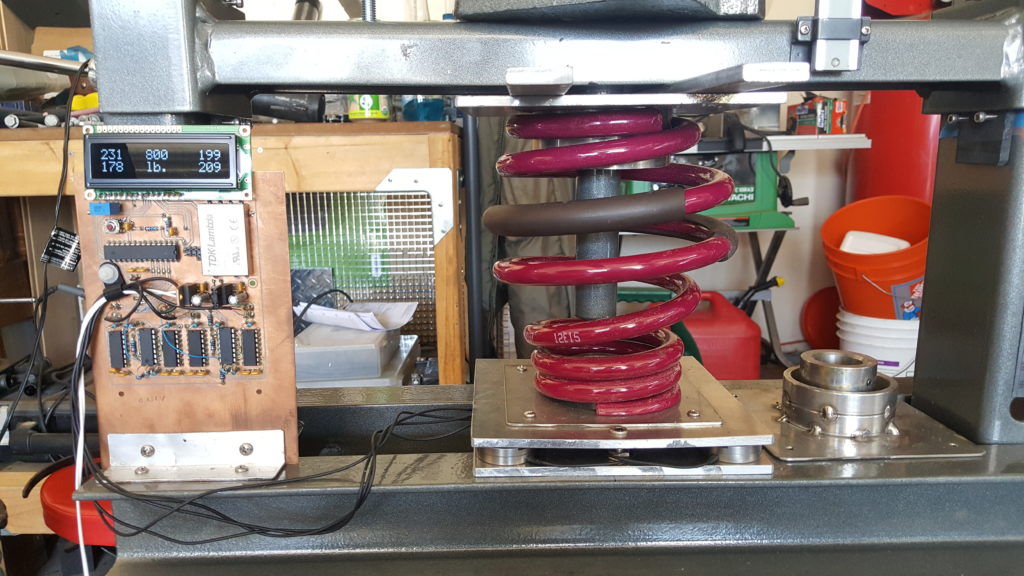
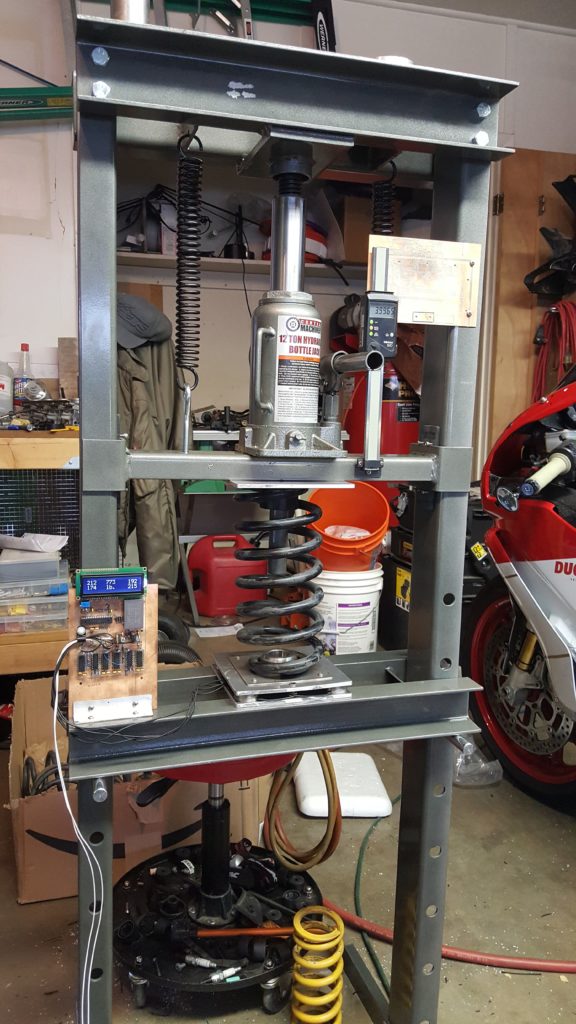
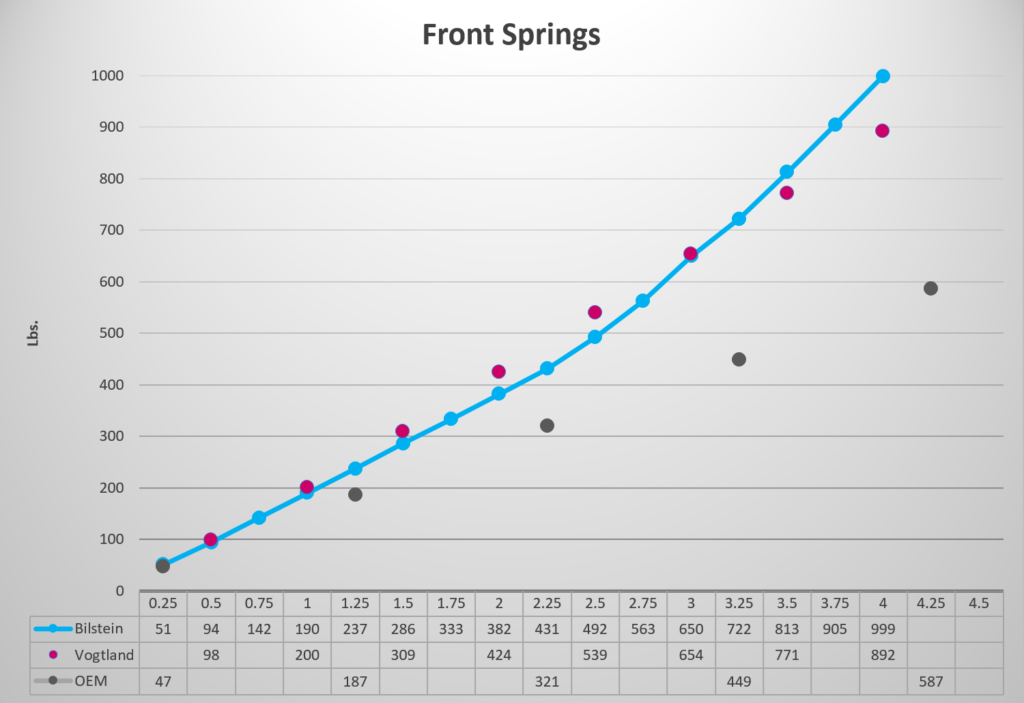
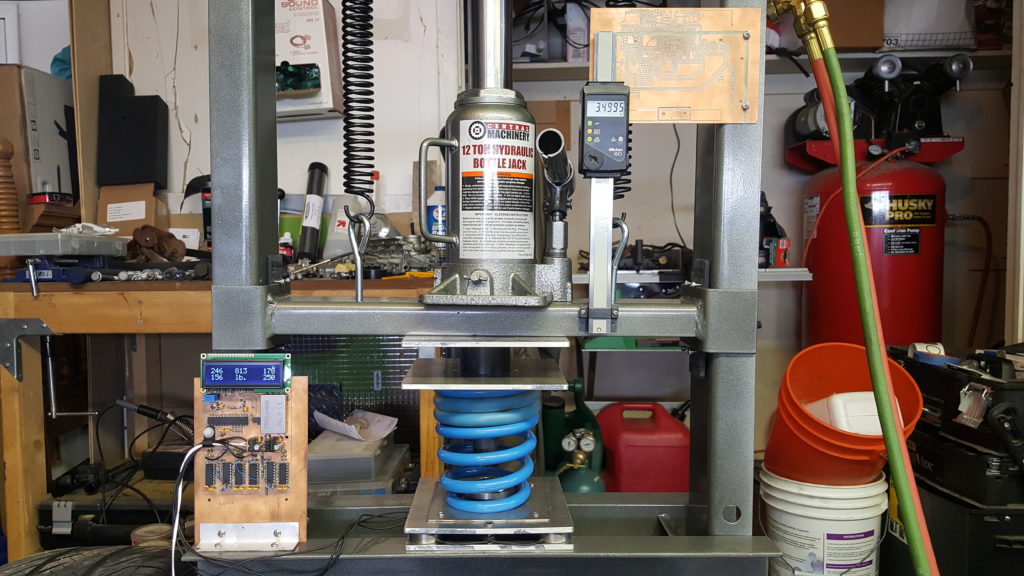
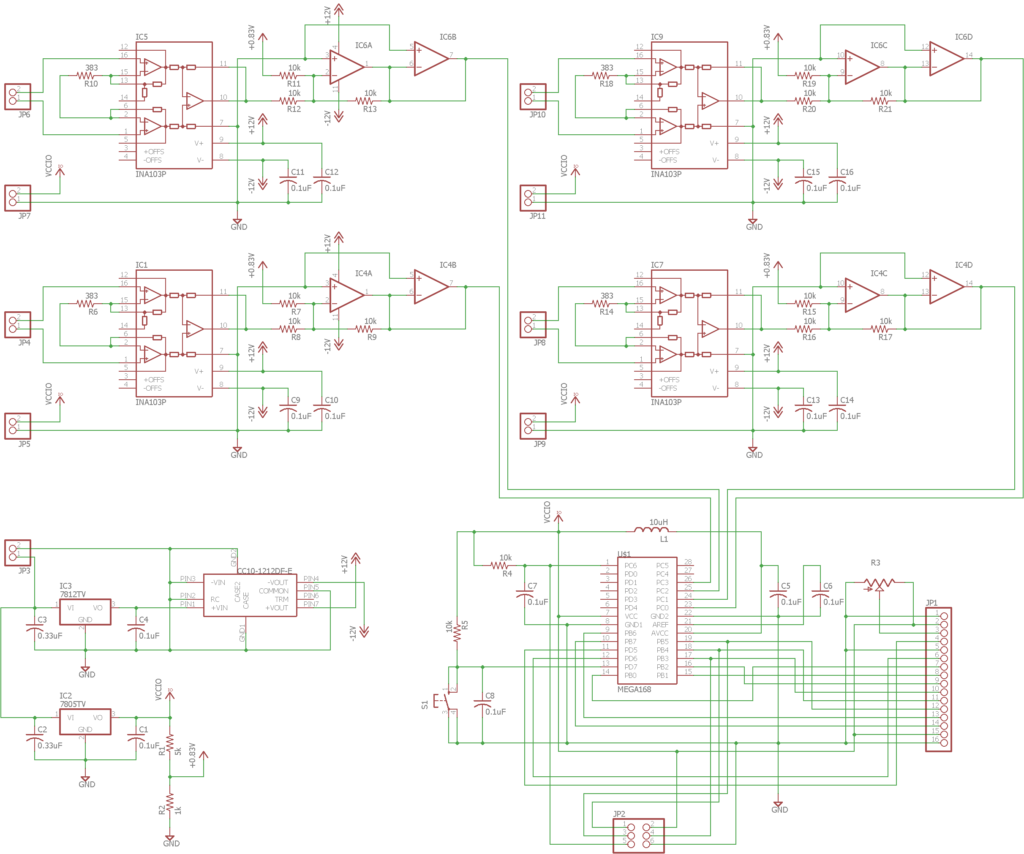
no video of the test, who then cares.
A modern F1 car actually has no true suspension travel at all. The suspension is a rigid system and they use deflection of rigid members as the suspension.
Yeah, because video compressing a spring a little bit at a time and then measuring would be so exciting.
What car are the springs made for? How much does your car weigh?
They’re for a B6 Passat, MKV Golf/GTI jetta etc.
My car is supposed to weigh just over 3000 lbs.
It’s hard to imagine that this is the correct kit. For a car that weighs 3000lbs you would need a spring rate closer to 400-600 lbs/in. “Springs should typically be compressed 25-30% of the free length when supporting the weight of the vehicle.”
You also need to consider the geometry of the suspension as it will most likly increase the force applied to the spring. Give this article a read, it explains adjusted spring force and how to calculate it.
https://www.qa1.net/tech/documents/Spring-Rate-Chart-Vehicle-Weights.pdf
Believe me I contacted Bilstein tech support and ECS tuning a couple times each and basically got told to quit whining. I made them verify part numbers so I could check if I had the right stuff. The spring is roughly 75% compressed at ride height. The kit basically relies on crazy levels of damping to hide how poorly matched the spring is. It was basically like riding in a gokart. I actually drove a gokart today, the B14 nostalgia was strong.
Regarding suspension geometry and static load, these are front springs from a FWD McPherson setup so motion ratio in the front is something like .98. The spring rate and wheel rate are close enough to be equal for this test.
I find it interesting that so many people think these cars need ^500lbs/in spring rates when the OEM rate is ~135 lbs/in. For a race car sure but if you’re using a 500 lb/in spring you have maybe 1.5″ of total droop travel which on a street car is not really that good. You will be dropping into potholes. The whole car, not just the wheel. Hit a pothole in a corner and you’ll unsettle the car, possibly losing control if your countersteering skills aren’t up to par. I know what this is like because the high rate of rebound damping on the B14 kit kept the wheel from traveling down into potholes and big bumps, so driving in the rain and snow the car was a real handful.